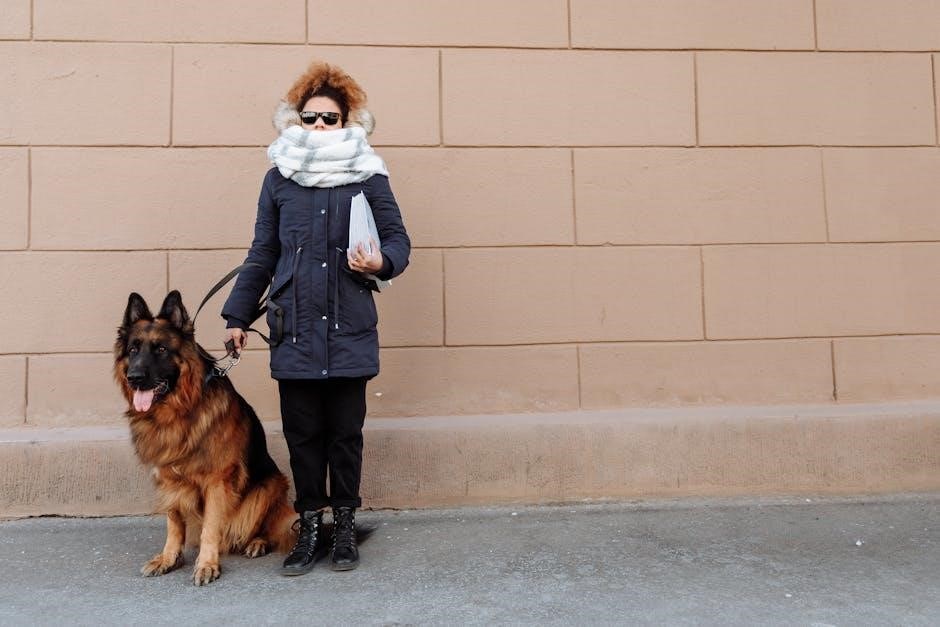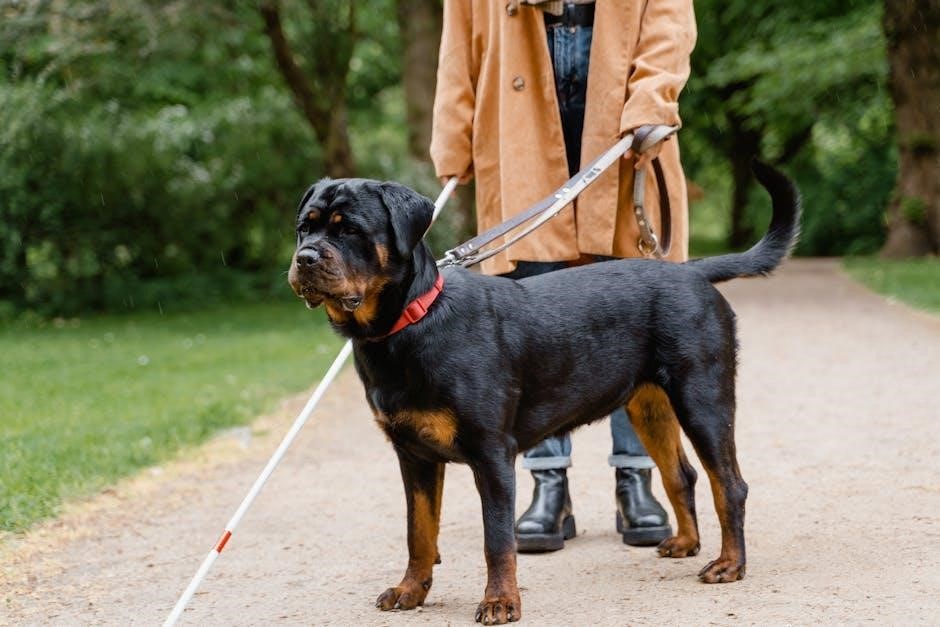A cystotomy is a surgical procedure where a vet opens the bladder to address issues like bladder stones, tumors, or infections. It’s a common, effective treatment for urinary problems in dogs, ensuring their comfort and health by removing obstructions and resolving pain. With proper care, most dogs recover well and resume normal activities.
1.1 What is a Cystotomy?
A cystotomy is a surgical procedure where a veterinarian makes an incision into a dog’s urinary bladder to address various health issues. It is most commonly performed to remove bladder stones, which are mineral clumps that can cause pain and obstruction. The procedure involves opening the bladder, removing problematic material, and flushing the area to ensure all stones are eliminated. A cystotomy is typically done under anesthesia, ensuring the dog remains pain-free during the operation. The incision is usually made through a midline abdominal incision, and the bladder is carefully closed with sutures after the stones are removed. This surgery is a critical treatment for urinary tract issues, providing relief and preventing further complications in dogs.
1.2 Importance of Cystotomy in Canine Health
Cystotomy is a vital surgical procedure for addressing urinary bladder issues in dogs, playing a crucial role in maintaining their overall health. By removing bladder stones, tumors, or infections, it prevents severe complications like urinary obstruction, which can be life-threatening if left untreated. This surgery not only alleviates pain and restores normal urination but also improves the dog’s quality of life. Early intervention through cystotomy can prevent long-term damage to the bladder and kidneys, ensuring better health outcomes. It is particularly essential for dogs prone to recurring urinary issues, as it provides a definitive solution to persistent problems. Regular veterinary care and post-surgery management further enhance the benefits of this procedure, making it a cornerstone in canine urinary health management.

Indications for Cystotomy in Dogs
Cystotomy in dogs is primarily indicated for bladder stones, tumors, infections, ectopic ureters, and obstructive urinary issues, serving as a critical procedure to resolve these conditions and restore normal function.
2.1 Bladder Stones and Their Impact
Bladder stones, or uroliths, are hard mineral deposits that form in the urinary bladder of dogs, causing severe pain and obstructing urine flow. These stones develop from concentrated minerals in urine, often due to genetics, diet, or underlying health conditions. If left untreated, bladder stones can lead to infections, inflammation, and life-threatening urinary blockages. Symptoms include frequent urination, straining, and blood in urine. In severe cases, stones may obstruct the urethra, preventing urination entirely, which is a medical emergency. Cystotomy is the primary treatment to remove these stones, ensuring proper urinary function and preventing future complications. Addressing bladder stones promptly is crucial for restoring your dog’s comfort and overall health.
2.2 Other Conditions Requiring Cystotomy
Besides bladder stones, cystotomy is essential for treating various other urinary bladder conditions in dogs. These include severe infections, tumors, or foreign bodies obstructing the bladder. Ectopic ureters, a congenital defect where urine flows incorrectly, may also necessitate surgery. Additionally, cystotomy is used to address bladder trauma, strictures, or polyps causing urinary issues. In some cases, it aids in diagnosing unexplained bladder abnormalities. While bladder stones are the most common reason, these other conditions highlight the versatility of cystotomy in resolving diverse urinary problems, ensuring proper bladder function and improving your dog’s quality of life. Early intervention is crucial to prevent complications and restore normal urinary health.

Preparing Your Dog for Cystotomy
Preparing your dog for cystotomy involves pre-surgical diagnostic tests, dietary adjustments, and activity restrictions to ensure safety and optimal surgical outcomes.
3.1 Pre-Surgical Diagnostic Tests
Before a cystotomy, diagnostic tests are essential to ensure your dog is fit for surgery. These include blood work to assess organ function, urinalysis to evaluate bladder health, and imaging such as X-rays or ultrasound to confirm bladder stones or other abnormalities. These tests help identify any underlying conditions that may affect surgery. A complete physical examination is also conducted to ensure your dog’s overall health. The results guide the surgeon and anesthesiologist to minimize risks and tailor the procedure to your dog’s needs.
3.2 Dietary and Activity Restrictions
Before undergoing a cystotomy, your dog may need to follow specific dietary and activity restrictions. The veterinarian may recommend a special diet designed to reduce the risk of bladder stone formation and support urinary health. This often includes prescription diets that are low in certain minerals and proteins. Activity levels should be limited to prevent overexertion, which could complicate the procedure or recovery. Dogs should avoid strenuous exercise or rough play, as this can increase the risk of injury or stress. These restrictions are typically in place for a few weeks before surgery to ensure your dog is in the best possible condition for the procedure and recovery.

The Surgical Procedure
Cystotomy involves opening the bladder to remove stones or address abnormalities. The procedure includes incision, stone removal, flushing, and closure, performed under anesthesia by a skilled veterinarian.
4.1 Anesthesia and Preparation
The surgical procedure begins with the administration of general anesthesia to ensure your dog remains pain-free and immobile during the operation. Anesthesia is carefully monitored to maintain your dog’s stability throughout the procedure. Before surgery, your dog will be fasting as per the veterinarian’s instructions to prevent any complications. Diagnostic tests are conducted to assess overall health and ensure safety for anesthesia. The abdominal area is shaved and cleaned to prepare for the incision. Monitoring equipment is in place to track vital signs, ensuring a safe surgical experience. Proper preparation and anesthesia are crucial for the success of the cystotomy procedure, minimizing risks and promoting a smooth recovery for your dog.
4.2 Surgical Approach and Incision
The surgical procedure begins with a caudal abdominal midline incision, extending from just below the umbilicus to the pubic area. This approach provides optimal access to the urinary bladder. The abdomen is carefully opened, and the bladder is identified and isolated from surrounding tissues; Moistened laparotomy swabs are used to pack off the bladder, minimizing contamination and improving visibility; The incision into the bladder is made on the ventral aspect, avoiding the ureters and urethra. This technique ensures precise access to the bladder’s interior, allowing for effective removal of stones or treatment of other abnormalities. The surgical approach is designed to minimize trauma and promote a smooth recovery for your dog.
4.3 Stone Removal and Bladder Flushing
After the incision into the bladder, the veterinarian carefully removes all stones or other abnormalities. The bladder is then thoroughly flushed with sterile saline solution to eliminate any remaining fragments or debris. This step is crucial to ensure no small stones or sediment are left behind, which could lead to future blockages or infections. The flushing process also helps to clean the bladder lining, promoting healing and reducing the risk of complications. Once the bladder is clear, the procedure moves on to closure, ensuring the bladder is watertight and functional; This meticulous process ensures your dog’s urinary system returns to normal function post-surgery.
4.4 Closure Techniques
After stone removal, the bladder is carefully closed to ensure a watertight seal. The incision is typically sutured in one or multiple layers, depending on the thickness of the bladder wall. A simple continuous or interrupted suture pattern is often used, with preference for monofilament, absorbable sutures to minimize irritation. The abdominal wall is then closed in layers, starting with the linea alba and followed by the subcutaneous tissue and skin. Proper closure is critical to prevent leakage of urine into the abdomen, which could lead to infection or other complications. The goal is to restore the bladder’s integrity while promoting healing and preventing post-operative issues.

Post-Operative Care
Post-operative care involves monitoring for signs of infection, managing pain, and restricting activity to promote healing. Proper wound care and follow-up vet visits are essential for recovery.
5.1 Immediate Recovery and Monitoring
After cystotomy surgery, your dog will need close monitoring to ensure a smooth recovery. They may be groggy from anesthesia, so provide a quiet, comfortable space. Monitor for signs of pain, infection, or complications, such as redness, swelling, or discharge at the incision site. Your vet may prescribe pain medication to keep your dog comfortable. It’s crucial to follow all post-operative instructions, including activity restriction, to prevent disrupting the sutures. Watch for unusual behaviors, like vomiting or lethargy, and contact your vet immediately if you notice any concerning symptoms. Proper care during this phase is vital for healing and preventing post-surgical issues.
5.2 Pain Management Strategies
Pain management is crucial for your dog’s recovery after cystotomy. Veterinarians typically prescribe pain relief medications, such as opioids or non-steroidal anti-inflammatory drugs (NSAIDs), to ensure your dog remains comfortable. These medications help alleviate surgical pain and reduce discomfort during the healing process. In some cases, additional therapies like laser treatment or acupuncture may be recommended to enhance recovery. It’s essential to follow your vet’s instructions precisely to avoid overmedication or side effects. Monitor your dog’s behavior for signs of pain, such as whining or restlessness, and adjust their care accordingly. Proper pain management supports a smoother and more stress-free recovery for your dog.
5.3 Activity Restriction and Wound Care
After a cystotomy, restricting your dog’s activity is vital to ensure proper healing and prevent complications. Limit your dog’s movement for 7-10 days, avoiding jumping, running, or strenuous play. Use a harness instead of a collar to reduce pressure on the surgical site. Monitor the incision daily for signs of infection, such as redness, swelling, or discharge. Keep the area clean and dry, and avoid bathing your dog during this period. Follow your veterinarian’s guidance for wound care, as improper handling can lead to infection or delayed healing. Adhering to these precautions will promote a smooth recovery and minimize the risk of post-surgical issues.

Dietary Considerations Post-Surgery
A balanced, veterinarian-recommended diet is crucial post-cystotomy to prevent stone recurrence. Focus on low-mineral, easily digestible foods, and avoid excessive protein or phosphorus. Proper nutrition aids healing and reduces future risks.
6.1 Nutritional Advice to Prevent Recurrence
Post-cystotomy, a tailored diet is essential to minimize bladder stone recurrence. Feeding a low-mineral, balanced diet can help regulate urine pH and reduce mineral buildup. Veterinarians often recommend prescription diets formulated to prevent specific types of stones, such as calcium oxalate or urate stones. Avoid foods high in phosphorus, protein, or sodium, as these can increase the risk of stone formation. Ensuring adequate hydration is critical, so encouraging water intake through wet food or additional water sources is advised. Regular monitoring of your dog’s diet and urinary health, along with follow-up vet visits, can significantly reduce the likelihood of future bladder stones and support overall urinary wellness.
6.2 Role of Prescription Diets
Prescription diets play a crucial role in preventing bladder stone recurrence post-cystotomy. These specialized diets are formulated to control mineral levels, reduce urine pH, and limit the formation of crystals that can lead to stones. Veterinarians often recommend specific diets based on the type of stones your dog had, such as calcium oxalate or urate stones. By adhering to these diets, you can significantly lower the risk of future bladder issues. It’s essential to follow your vet’s dietary recommendations closely, as these diets are tailored to your dog’s specific needs. Consistent use of prescription diets, combined with regular check-ups, can help maintain your dog’s urinary health and prevent recurrence of stones.

Potential Complications and Risks
Complications of cystotomy may include infection, bladder leakage, or recurrence of stones. Monitoring for signs like lethargy or urination difficulties is crucial for early detection and treatment.
7.1 Common Post-Surgical Issues
After a cystotomy, dogs may experience several common post-surgical issues. Infection is a primary concern, as the bladder is prone to bacterial invasion during and after the procedure. Leakage from the surgical site or bladder is another potential complication, which can lead to further health problems if not addressed promptly. Additionally, some dogs may develop urinary incontinence or difficulty urinating, which are usually temporary but require close monitoring. Pain management is also crucial, as improper pain control can lead to discomfort and stress for the dog. Monitoring for signs such as lethargy, lack of appetite, or unusual urination patterns is essential to ensure a smooth recovery. Regular follow-ups with the veterinarian are recommended to check for any adverse reactions and ensure the bladder is healing properly. Early detection of these issues can significantly improve the dog’s recovery outcome and overall well-being.
7.2 Recognizing Complications Early
Recognizing complications early after a cystotomy is crucial for ensuring your dog’s recovery. Monitor for signs of infection, such as redness, swelling, or discharge at the surgical site. Leakage from the incision or unusual urination patterns, like straining or blood in the urine, should be reported to your vet immediately. Lethargy, loss of appetite, or vomiting may indicate internal issues. A foul odor or cloudy urine could signal a urinary tract infection, a common post-surgical complication. Keep an eye on your dog’s overall behavior and watch for any deviations from normal recovery progress. Early detection of these issues allows for timely intervention, improving outcomes and reducing the risk of severe health problems. Regular follow-ups with your veterinarian are essential to monitor healing and address any concerns promptly.

Preventing Future Bladder Stones
Preventing future bladder stones involves dietary changes, increased hydration, and regular veterinary check-ups to monitor urinary health and address potential issues early.
8.1 Lifestyle Adjustments
Lifestyle adjustments play a crucial role in preventing future bladder stones in dogs. Ensuring adequate hydration is key, as water helps dilute urine and reduce mineral concentration. Feeding a balanced, veterinarian-recommended diet tailored to your dog’s specific needs can prevent mineral buildup. Regular exercise promotes overall health and maintains a healthy weight, reducing the risk of obesity-related urinary issues. Avoiding stress and providing a calm environment can also support urinary health. Additionally, limiting access to certain foods and supplements that contribute to stone formation is essential. By making these adjustments, pet owners can significantly lower the likelihood of recurrence and improve their dog’s long-term well-being.
8.2 Regular Veterinary Check-Ups
Regular veterinary check-ups are essential for monitoring your dog’s health after a cystotomy and preventing future bladder issues. Scheduled visits allow your vet to assess recovery progress, check for any signs of bladder stones, and ensure the bladder is functioning normally. Routine urinalyses and imaging can help detect early signs of stone formation or other abnormalities. Your vet may also recommend adjustments to your dog’s diet or lifestyle based on their condition. Regular check-ups provide peace of mind and help prevent complications. By staying proactive, you can ensure your dog remains healthy and reduce the risk of recurrence. Consistent monitoring is key to maintaining your dog’s well-being and preventing future surgeries.

Understanding the Cost of Cystotomy
The cost of a dog cystotomy varies based on factors such as location, veterinarian fees, dog size, and surgical complexity. Average costs range from $500 to $2,000.
9.1 Factors Influencing Cost
The cost of a cystotomy in dogs can vary significantly based on several factors. These include the size and breed of the dog, as larger breeds often require more resources and time. The complexity of the procedure, such as the number of bladder stones or additional surgical needs, also impacts the price. Diagnostic tests like X-rays or ultrasounds add to the overall expense. The veterinarian’s fees, which can differ based on their experience and location, play a major role. Additionally, post-operative care, including hospitalization and medication, contributes to the total cost. These factors combined mean that pet owners should expect a detailed breakdown of expenses from their vet to understand the financial commitment involved.
9.2 Insurance and Financial Options
Pet insurance can significantly help cover the cost of a cystotomy, depending on the policy’s coverage. Some insurance plans may reimburse a portion or all of the surgical expenses, while others may exclude pre-existing conditions. It’s crucial for pet owners to review their insurance policies carefully to understand what is covered. Additionally, many veterinary clinics offer payment plans or financing options to make the procedure more affordable. Non-profit organizations and crowdfunding platforms can also provide financial assistance for pet owners in need. Discussing these options with your veterinarian can help identify the best way to manage the costs and ensure your dog receives the necessary care without financial strain.
Cystotomy is a vital procedure for addressing bladder issues in dogs, offering effective relief from stones and infections. With proper care and veterinary guidance, most dogs recover fully, ensuring their health and well-being.
10.1 Summary of Key Points
A cystotomy is a surgical procedure where the bladder is opened to address issues like bladder stones, infections, or tumors. It is a common and effective treatment for urinary problems in dogs, providing relief from pain and obstruction. The procedure involves making an incision in the abdomen and bladder, removing problematic material, and flushing the bladder before closing the incision. Proper pre-surgical preparation, post-operative care, and dietary adjustments are crucial for a smooth recovery. With attentive care, most dogs recover fully and resume normal activities. Cystotomy is a life-saving intervention for many dogs, ensuring their health and well-being by resolving urinary issues effectively.
10.2 Encouragement for Pet Owners
While the thought of your dog undergoing a cystotomy can be daunting, it’s important to remain positive and proactive. This procedure is a proven, effective solution for resolving bladder issues and improving your dog’s quality of life. By following your veterinarian’s guidance and ensuring proper post-operative care, you can help your dog recover smoothly and prevent future complications. Your love, support, and attention to their needs will play a significant role in their healing journey. Remember, dogs are resilient, and with the right care, they can bounce back and enjoy a healthy, happy life. Stay informed, trust your vet’s expertise, and focus on providing a nurturing environment for your furry friend.

Resources for Further Reading
For more details, visit VETgirl, Veterinary Surgery journals, or the American Animal Hospital Association. These resources offer comprehensive guides and expert insights on dog cystotomy and post-care.
11.1 Recommended Websites and Literature
- VETgirl: Offers detailed video blogs and step-by-step guides on cystotomy procedures and post-operative care.
- American Animal Hospital Association (AAHA): Provides guidelines and resources for pet owners on surgical procedures and recovery.
- Veterinary Information Network (VIN): Features in-depth articles and expert advice on bladder surgery and stone prevention.
- Veterinary Surgery Journals: Academic publications with case studies and surgical techniques for bladder surgeries in dogs.